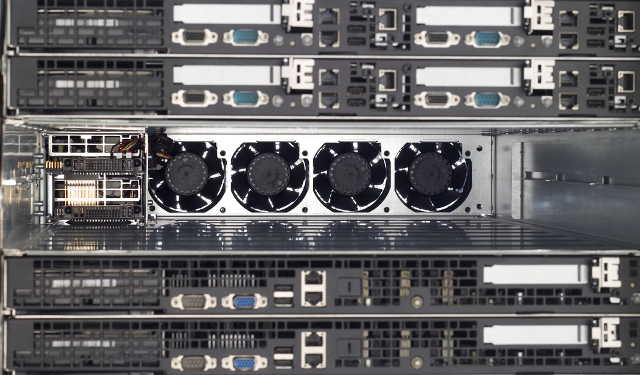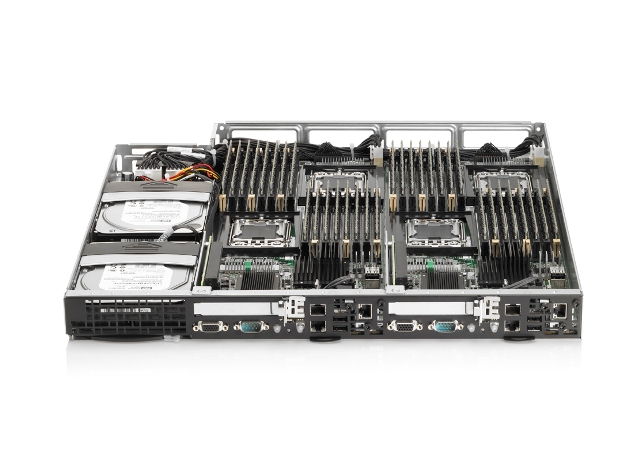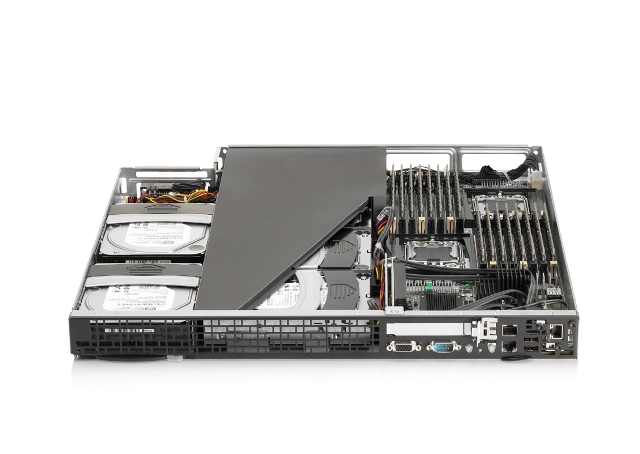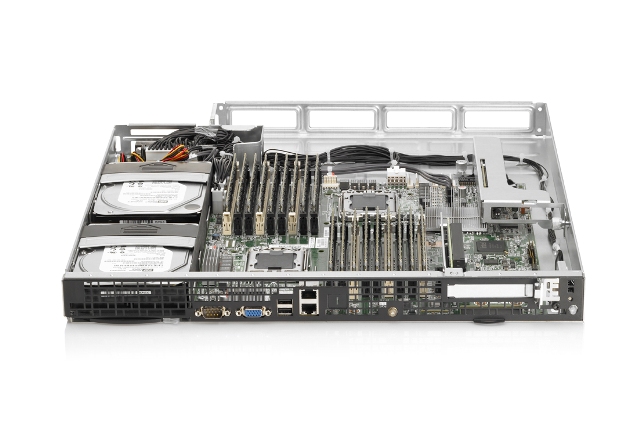June 10, 2009
HP SL6000 Scale Out Servers
If plagiarism is the sincerest form of flattery then the IBM iDataplex team should take a bow. The design of the recently announced HP SL6000 scale out series is almost a spitting image of the IBM iDataplex product. Of course, the IBM iDataplex product had a scary resemblance to Rackable's design that predated both by a number of years.
Besides cost considerations, one factor that pushed HP to this design is that their shipping container solution was untenable without front I/O access. HP needed a shallower chassis with I/O out the front so they could make the container serviceable. The SL6000 chassisses are still too deep to double the number of racks in the container but I wouldn't discount HP's design team ability to get creative with the new form factor.
Like IBM's iDataplex offering the HP SL6000 is a 2U chassis that contains fans and power supply. Compute capacity is then added to the chassis in the form of swappable trays. Unlike the iDataplex offering HP is only offering 1U form factor trays right now. I really liked iDataplex's four 3.5" disk tray that stacked neatly on top of a 1U compute tray. IBM also offered a 3U chassis that housed 12 3.5" disks and a single 1U compute tray. The flexibility of the IBM made it really easy to retask existing hardware for new uses.
One differentiating feature of the SL2x170z, which fits two half width system boards on a single 1U tray, is the memory capacity. There are 16 DIMM slots on the board which is 33% more than Dell, Supermicro, and Quanta half width boards. Another nifty feature is the integrated status indicators and power switch on the planar. This eliminates the need for additional wiring and PCB for switches and status indicators. The biggest downside appears to be the lack of IPMI or any sort of remote management on the planar. The SL170z uses a Raritan Peppercon based add-in card which is strange in this day and age of Aspeed and ServerEngines integrated video and BMCs.
The SL170z is a single planar 1U tray with room for six 3.5" disks. This is a pretty reasonable density for a dual processor system with six disks. Dell and Supermicro acheive similar density with their scale out offerings but have easier to service drives. HP will need to come in at a lower price point to make up for the hindered serviceability.
The SL160z tray isn't two exciting. It uses a mostly standard EATX/EPS form factor systemboard in a 1U tray. It only holds two hard drives but does feature 18 DIMMs slots. The extra memory capacity is probably only useful for the memcached crowd. I do like the second oddly placed PCIe slot which allows two half heigh half length add-in cards to be fitted in the 1U chassis. The second slot would be more useful if the tray could hold more disks.
One final thought - HP is offering three power supplies for the 2U chassis - 460, 750, and 1200 watts. Part of this is out of necessity due to the various configurations possible with each chassis. The benefit is that the power supply can be sized to the load instead of the typical scenario where the power supply is oversized by a factor of 3 or 4. Rackable "got" this from the start but even IBM missed this with their iDataplex offering.
Posted by cary at 10:58 AM
April 28, 2009
Cold Aisle Containment and Rack Filler Panels
I met the president of Polargy, Cary Frame, today at a Server Technology event. Polargy makes cold and hot aisle containment products. Their polycarbonate and extruded aluminum panels look a bit nicer than other solutions I've come across. Polargy typically uses vinyl curtains for end of aisle containment.
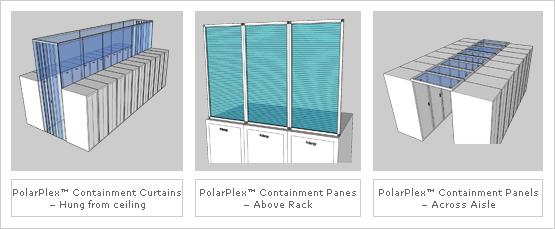
Polargy also represents other manufacturers' product lines such as UpSite HotLok blanking panels and PlenaForm PlenaFill blanking panels. I've used the HotLok panels for some time and they're well engineered, stack for easy storage, and snap fit for easy installation. Unfortunately they cost over $5 per 1U panel which is a little pricey to fill a rack if it's only half used. Enter Plenafill to the rescue. Plenafill panels are made of ULV94-0 flame retardant polypropylene in perforated die cut 27U size sheets. There are several types of plastic rivets for attaching the sheets to square hole, round hole, or threaded rack rails. These should work well for sealing large openings in partially filled racks. Plenafill panels are about half the cost of the UpSite HotLok panels.
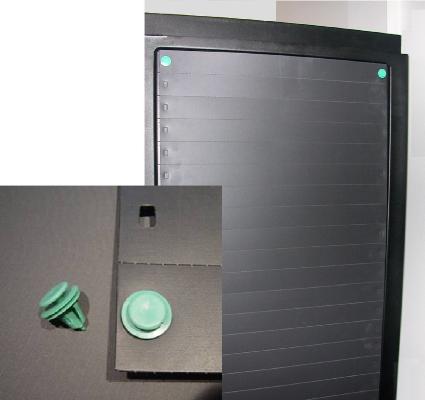
Posted by cary at 4:33 PM
April 10, 2009
ServerTech Powerstrips With Per Outlet Sensing
Server Technology has released a new series of power strips with per outlet sensing capability. Unlike previous generations of power strips which only measure voltage and current at the input to the power strip, the new ServerTech POPS strips measure current, voltage, watts, volt amps, and power factor for each and every outlet. This product will allow IT managers to get a better handle on power consumption of loads within a rack without resorting to using multiple Watts Up Power Meters.
I hope this capability will encourage the decommissioning of older inefficient servers (can you say Intel Netburst?) and charge back of resources to product and application owners.
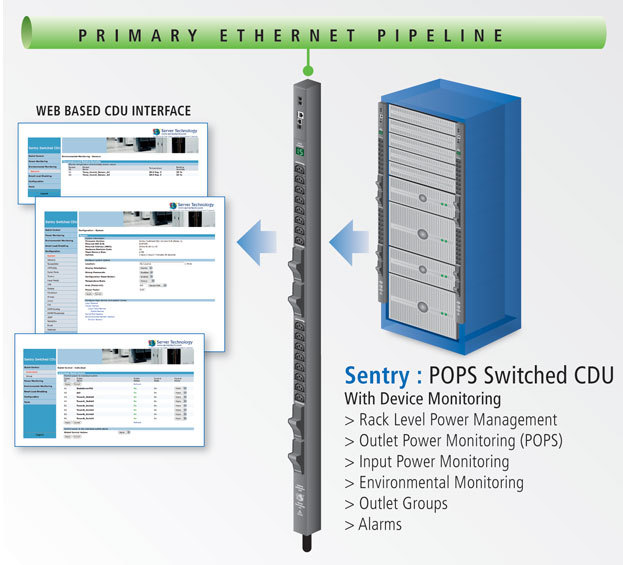
The power strips are currently available in several configurations including single phase, three phase, and a new three phase 415V unit. Pricing should be about 30% more than existing fully managed products but the visibility into power usage offers value that more than offsets the additional cost.
Posted by cary at 10:55 AM
September 18, 2008
Intel Air Side Economization Study
Intel announced the results of a ten month long study of air side economizers at one of their New Mexico facilities:
Intel set up 448 blade servers in each of two 500sqft rooms in a modular building space, totalling over 100kw of critical load per room. They used a commercial ducted DX packaged unit for cooling one of the spaces, and the same make and model cooling package using 100% outside air for the other space. The unit drawing 100% outside air was configured to start cooling if the intake air exceeded 90F. That's pretty warm even for high air flow servers.
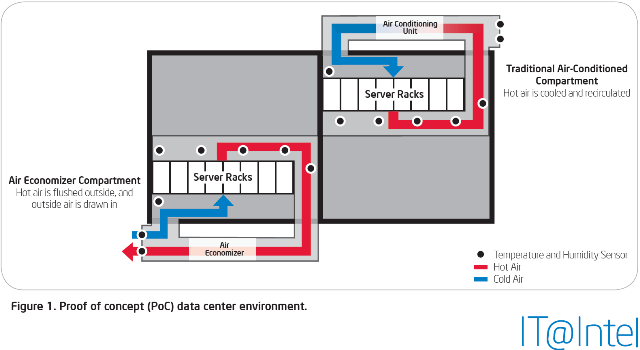
Server failure of the outside air room was almost double that of the closed loop room: 4.46% vs 2.45%. Intel didn't find the increased failure rate to be an issue but I'm sure their server vendors warranting the equipment would disagree.
Bill Tschudi and others at Lawrence Berkeley have done a good bit of research on particulate in datacenters using air side economizers. It's available here:
Posted by cary at 4:25 PM
April 22, 2008
IBM Announces iDataPlex line
The press folks at IBM have jumped the gun and posted a video of their new iDataPlex line in advance of the official announcement tomorrow morning. The video on their press site does little to demonstrate how it's any different that what is currently available on the market. There are a few glimpses of the actual hardware 1 minute and 25 seconds into the 140MB windows media file.
http://ibm.com/press/video/iDataPlex_FINAL.wmv
Hopefully there will be better details of the product line tomorrow. From the brief glimpses in the movie it looks like yet another Rackable clone.
Posted by cary at 6:53 PM
March 20, 2008
World Class Datacenter?
It was interesting to see a picture of my handiwork on the March 3 issue of InformationWeek. The photo appears to be 3 years old based on the servers shown in the racks. I'm sure Tellme/Microsoft didn't intend for this picture to ever be public.
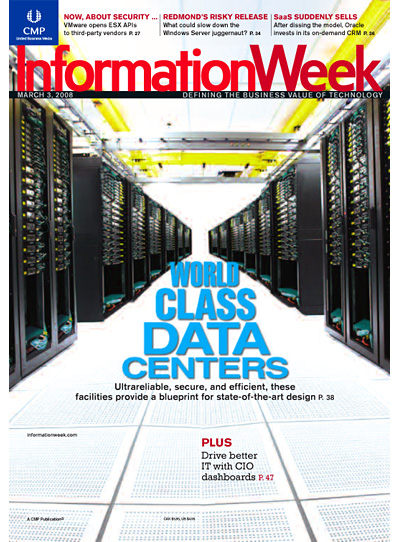
Posted by cary at 7:00 PM
March 17, 2008
Critical Facilities Roundtable Meeting 03/12/08
I attended the Critical Facilities Roundtable meeting on Wednesday, hosted at the Altera campus.
The first 20 minutes were for announcements and other meeting business:
- Charles suggested we pursue research using the power grid as a generator load bank instead of resistive on site load banks. This of course requires power company cooperation and with PGE in the room it put some pressure on them.
- LBNL announced they will be releasing a datacenter profiling tool in May.
- LBNL will release the results of the LBNL and Sun "Chill Off" this summer.
- On Friday April 11 there will be a tour for interested parties of a supposedly Platinum LEED carbon neutral datacenter in Sonoma Mountain Village.
Altera and PGE then discussed the cold aisle containment retrofit of the Altera datacenter in building 3. The datacenter consists of 8-10 rows of 6-8 cabinets with each hot aisle and cold aisle enclosed on one side by a wall. There were four pre-existing air handlers in the room, two DX CRACs and two water CRAHs.
They gathered the following data:
- Temperature probes on the inlet and discharge side of the CRACs and CRAHs
- Four temperature probes in each cold aisle
- Current taps on the CRAC condensers to measure load
- Power draw of each rack
The data showed that:
- Only 40% of conditioned air was used to cool the servers
- They were conditioning 2.6 times more air than necessay
- Server face temperature varried from 68F to 77F
- CRAC delta T was only 12F to 18F
Based on the gathered data Altera believed they could benefit from hot aisle containment. They acheived this by:
- Installing blanking plates on the fronts of all server racks to fill empty rack spaces
- Adding clear vinyl strip curtains on the aisle side of each cold aisle
- Fabricating sheet metal barriers between the tops of the racks and the drop ceiling
- Removing perf tiles from the hot aisles
- Ensuring adequate sprinkler head coverage (two per aisle) in both the hot aisles and cold aisles
- Installing APC InRow RC water cooled air handlers in the high density rack line ups
After the retrofit Altera was able to cut energy use by 44.9KW with an annual savings of 393MWHrs.
Some notes from the Q&A session:
- Altera used polyurethane foam between the metal partition wall and the tops of racks to seal up any open areas
- The APC InRow units are fed by building chilled water and each have their own VFDs for fan speed control and well as electronically operated balancing valve
- The main 30 ton CRAH in the room is used to handle primary cooling and humidity control
- If segregation wall is deemed a temporary structure then there is no requirement to refit the sprinkler heads
- Altera will be using strip curtains with fusible links above the racks in their next build to avoid relocating sprinkler heads
- Sprinklers were already in place above the interstitial area (drop ceiling)
Following the Altera presentation Validus DC gave a presentation on their high voltage DC distribution scheme. Since I've seen this presentation before I didn't take notes. They did mention they have a large datacenter getting ready to deploy multiple 2.5mw pods/modules/colos in their next datacenter. I can only assume this to be one of the big three search engine properties. While there certainly are benefits to Validus's 540V and 48V distribution strategy, I'd rather see 380V DC distribution all the way to each server instead of stepping down to 48V at the row or rack level. This would cut out another stage of conversion and associated losses.
Posted by cary at 7:19 AM
June 21, 2007
USENIX 2007 Talk - Trends in Datacenter Efficiency
I presented a session at covering trends in datacenter efficiency. The attendees were a mix of HPC users (academic, render farm, search) along with high density corporate users and low density IT users. PDF of the presentation is available at:
http://www.tinkthank.com/public/usenix07_datacenter_efficiency_trends.pdf
Posted by cary at 5:23 PM
June 15, 2007
Critical Facilities Roundtable Meeting 06/15/07
I attended the Critical Facilities Roundtable meeting this morning at AMD's Sunnyvale campus.
I had hoped the first presentation on "Medium Pressure Overhead Ducting – Engineered Solutions" would have some useful data and include statistics on using outside air economizers. Unfortunately the presentation reviewed a single scenario with oversized supply ducts assisted with fans to provide proper airflow to distant ducts. There was little data backing up claims of increased fan energy efficiency.
The second discussion around EPA and legislation around datacenter efficiency was quite informative. Bill HR 5646 requires the EPA to report to congress by 6/22/07. The EPA must report on current datacenter trends and consider the energy implications of servers and datacenters. Bill Tschudi from LBNL believes the following:
- change will accelerate with top down intervention
- all areas of datacenters need to be addressed
- objective, credible information is needed
- prescriptive approaches won't work due to rapid change in industry
EPA Energy Star Datacenter Energy Efficiency Initiatives
PG&E (local CA power company) sponsored the LBNL study on particulate and humidity when using outside air economizers. The brief rundown is that in most cases particulate and humidity can be easily kept within ASHRE guidelines while benefitting from air side economizers. Even though airborne particulate concentrations werre higher when the economizers werre operating, particulate levels quickly drop once external air intakes were closed. The speaker commented that even the particulate concentrations measured outside in the parking lot were below ASHRE guidelines. All sites in the study were in the San Francisco and Sacramento area. KC Mares from Yahoo noted that they are seeing much higher particulate in the Quincy area due to dust kicked up by local farmers. More great documents and data available on the LBNL website.
There an unscheduled discussion towards the end on energy reduction due to segregating the hot aisle from the cold aisle. In the study they prevented air mixing and segregated the aisles with plastic sheeting. The temperatures measured at the bottom/middle/top of the rack were 55F/68F/79F before the seperation, and 55F/57F/59F after seperation. Ideally they would have raised the building cold water supply to deliver 70-75F air but were unable to do so in this study. They measured a reduction in fan energy of 75%. Tellme is using ducted fan hoods in one of our datacenters to prevent hot/cold air mix and it works really well. Based on this study it would appear that the datacenter we occupy could significantly reduce fan energy if all cabinets (and other customers) were equipped with ducted racks or hot aisles
Upcoming CF or CF related meetings:
- 7/9/07 - Presentation by Synopsys on Group Computing, also talk on Massive Array of Idle Disks
- 7/12/07 - Updates and Standards meeting @ Intel
- 7/13/07 - DCD
- 7/19/07 - Alternative AC and DC power distribution strategies - http://www.svlg.net/
- 7/20/07 - Next Critical Facilities Roundtable meeting, location TBD
Posted by cary at 10:13 AM
September 21, 2005
LEDs as input devices?!?
I came across Multi-Touch Sensing through LED Matrix Displays in a posting on the synth-diy mailing list. After some extended googling I found the notes from Forrest M Mims that Jeff Han referenced in the above link. It turns out that LEDs work as very narrowband (50nm) detector, producing around 2-5 microamps depending on the LED. The LED's peak sensitivity is about 30nm shorter than its emitted wavelength, so red emitters work great with yellow-orange LEDs as detectors, yellow emiiters work well with green LED detectors, and so forth. I already have a great idea about using bicolor LED dot matrix displays for real time interactive displays.
Posted by cary at 2:58 AM
July 30, 2005
Another fun fun upgrade
Just upgraded MT to 3.17 to fix some bugs and hopefully clean up comment spam from some other system users' blogs. I swear Movable Type has the most poorly implemented upgrade procedure of any software I've seen.
Posted by cary at 4:14 PM
July 12, 2004
A different three-oh
I've just upgraded Movable Type to 3.0. Why does their code always require so much tedious work just to get up and running?
Posted by cary at 1:55 AM
September 24, 2003
Applecare bites
Finally received a G4 non-DVI LCD to repair a friend's tibook today. Apple's design for the hinges is lacking any structural integrity and repairability forethought so what should be a $200 hinge repair requires the whole screen to be swapped. I'm sure the poor engineering choices were due to the designers wanting a nice thin display. Too bad Apple decided to epoxy the whole LCD mess together so you can't repair it without damaging the casing and LCD panel.
Posted by cary at 3:33 PM
September 1, 2003
Finally got a blog up and running
I'm way late to this blog game. I was finally incentivized into getting blog code running on my server for a friend's
website, so I figured I'd recycle the effort and do my own blog.
Posted by cary at 12:09 AM

